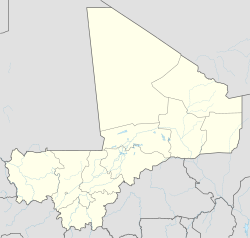San (Mali)
| San | ||
|---|---|---|
|
|
||
| Coordinates | 13 ° 18 ′ N , 4 ° 54 ′ W | |
| Basic data | ||
| Country | Mali | |
| Ségou | ||
| ISO 3166-2 | ML-4 | |
| height | 288 m | |
| Residents | 58,830 | |
|
The Friday Mosque of San
|
||
San is an urban settlement in the district of the same name in the Ségou region in Mali with 58,830 inhabitants. It is located south of the Bani , surrounded by abundant agriculture, which consists mainly of rice, corn and cotton. In addition, San is the center of Bogolan production. The spot is conveniently connected to the capital Bamako and Mopti .
The local population consists mainly of Markadialan , who differ ethnically from the Marka , Bambara , Mande and Dioula . Bozo , Fulbe and Songhai also live in the city. In addition to the permanent market, there is a large weekly market.
Sanké mon ritual festival
The Sanké mon festival is celebrated in San . It takes place every second Thursday of the seventh lunar month to commemorate the founding of the village. The ritual begins with sacrifices being made. Fish are then caught together with a wide variety of nets over many hours. Then there is dancing. The dancers wear traditional costumes with cowries and feathers. Well-rehearsed choreographies accompany the rhythms of the drums. Since 2009 the festival has been included in the List of Intangible Cultural Heritage in Need of Urgent Safeguarding .
Mosques
The Middle Niger region is characterized by a large number of mosques, regularly built to a high standard. The river regions of the Niger and the Bani are rich in large river oases that provide excellent building material. So it is not surprising that San alone has seven mosques in the district, which are considered to be quite magnificent.
The Friday Mosque is located under the mosques in the center of the village, bordering the market square to the west . It is built on a rectangular base area of 1,300 square meters, which is why it is one of the large mosques in the Niger Inland Delta. Within a very short construction period, it was built in 1941 as a clay mosque in the typical style of the architectural province of West and Central Sudan . As a courtyard mosque type, it follows the traditional model of the Middle iger region. The prayer room building is generously designed and laid across. The inner courtyard is to the west and is flanked by a gallery. The gallery facades end with corner pillars, the outer walls have numerous pilaster strips . The haram is structured by several transversal vessels. The propylon-like porch of the entrance is decorated with battlements , arched panels and ostrich egg jewelry. The entire complex (around 4000 square meters) is surrounded by a wall around 1 meter high. The mihrāb tower is almost 15 meters high. The Adhān pedestal is kept low. The mosque replaced a smaller previous building that was completed in 1875. The mosque goes back to an architect whose contribution has already produced the recent restoration of the Great Mosque of Djenné . The mosque is considered original and carefully executed.
There are more mosques in the districts of Dalla and Malholdi . They are smaller.
Town twinning
-
 Chaumont (Haute-Marne) - France , since 1995
Chaumont (Haute-Marne) - France , since 1995
literature
- Dorothee Gruner, The Lehmmoschee am Niger , documentation of a traditional building type, Franz Steiner Verlag Stuttgart, 1990, ISBN 3-515-05357-3
Individual evidence
- ↑ PLAN DE SECURITE ALIMENTAIRE COMMUNE URBAINE DE SAN ( page no longer available , search in web archives ) Info: The link was automatically marked as defective. Please check the link according to the instructions and then remove this notice. (PDF, French)
- ↑ In 1973 there were 23,000 inhabitants, s. Gruner, p. 170
- ↑ a b c d Dorothee Gruner, Die Lehmmoschee am Niger , p. 170 ff. / P. 43 ff. (See lit.)
- ↑ Lists of intangible cultural heritage and Register of best safeguarding practices (2009)
- ↑ Representative list of the intangible cultural heritage of mankind: Safeguarding Sanké mon, collective fishing rite of the Sanké
- ↑ Festival '' Sanké Mon '' à San: L'interdiction de la course de motos fait '' vrombir ''! (The fishing festival Sanké mon ) (mali.web, French)

